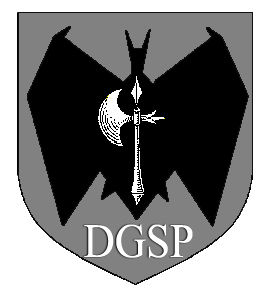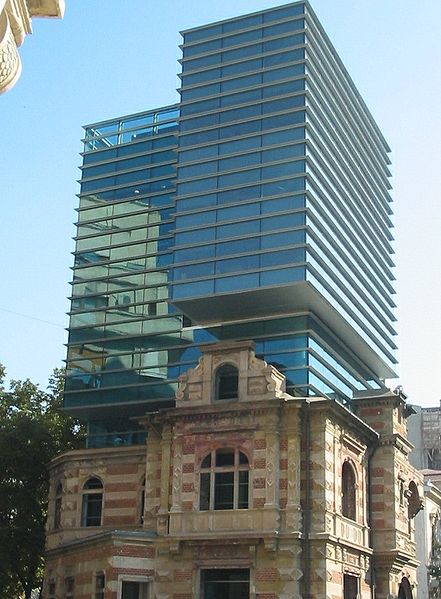<Back to Index>
- Romania Department of State Security (Securitate), 1948
PAGE SPONSOR


The Securitate (Romanian for Security; official full name Departamentul Securității Statului, Department of State Security) was the secret police agency of Communist Romania. Previously, the Romanian secret police was called Siguranţa Statului. Founded on August 30, 1948, with help from the Soviet NKVD, the Securitate was abolished in December 1989, shortly after President Nicolae Ceaușescu was ousted.
The Securitate was, in proportion to Romania's population, one of the largest secret police forces in the Eastern bloc. The first budget of the Securitate in 1948 stipulated a number of 4,641
positions, of which 3,549 were filled by February 1949: 64% were workers, 4% peasants, 28% clerks, 2% persons of unspecified origin, and 2% intellectuals. By 1951, the Securitate's staff had increased fivefold, while in January 1956, the Securitate had 25,468 employees. Under the regime of Nicolae Ceaușescu, the Securitate employed some 11,000 agents and had a half - million informers for a country with a population of 22 million by 1985.
Under Ceaușescu, the Securitate was one of the most brutal secret
police forces in the world, responsible for the arrests and deaths of
thousands of people.
The General Directorate for the Security of the People (Romanian initials: DGSP, but more commonly just called the Securitate) was officially founded on August 30, 1948, by Decree 221/30 of the Presidium of the Great National Assembly. However, it had precursors going back to August 1944, when communists began to organize it, following King Michael's Coup that took place then. Its stated purpose was to "defend democratic conquests and guarantee the safety of the Romanian Peoples' Republic against both internal and external enemies."
The Securitate was created with the help of SMERSH, the NKVD counter - intelligence unit. The SMERSH operation in Romania, called Brigada Mobilă ("The Mobile Brigade"), was led until 1948 by NKVD colonel Alexandru Nicolschi. The first Director of the Securitate was NKVD general Gheorghe Pintilie (born Panteleymon Bondarenko, nicknamed "Pantiuşa"). Alexandru Nicolschi (by then a general) and another Soviet officer, Major General Vladimir Mazuru, held the deputy directorships. Wilhelm Einhorn was the first Securitate secretary.
As Vladimir Tismăneanu says, "If one does not grasp the role of political thugs such as the Soviet spies Pintilie Bondarenko (Pantiuşa) and Alexandru Nikolski in the exercise of terror in Romania during the most horrible Stalinist period, and their personal connections with Gheorghe Gheorghiu - Dej and members of his entourage, it is difficult to understand the origins and the role of the Securitate".
Initially, many of the agents of the Securitate were former Royal Security Police (named General Directorate of Safety Police — Direcţia Generală a Poliţiei de Siguranţă) members. However, before long, Pantiuşa ordered anyone who
had served the monarchy's police in any capacity arrested, and in the
places of the Royal Security Policemen, he hired ardent members of the Communist Party, to ensure total loyalty within the organization.
In the 1980s, the Securitate launched a massive campaign to stamp out dissent in Romania, manipulating the country's population with vicious rumors (such as supposed contacts with Western intelligence agencies), machinations, frameups, public denunciations, encouraging conflict between segments of the population, public humiliation of dissidents, toughened censorship and the repression of even the smallest gestures of independence by intellectuals. Often the term "intellectual" was used by the Securitate to describe dissidents with higher education, such as college and university students, writers, directors and scientists who opposed the philosophy of the Communist party. Assassinations were also used to silence dissent, such as the attempt to kill high ranking defector Ion Mihai Pacepa, who received two death sentences from Romania in 1978, and Ceauşescu decreed a bounty of two million US dollars for his death. Yasser Arafat and Muammar al-Gaddafi set one more million dollars reward each. In the 1980s, Securitate officials allegedly hired Carlos the Jackal to assassinate Pacepa.
Forced entry into homes and offices and the planting of microphones was another tactic the Securitate used to extract information from the general population. Telephone conversations were routinely monitored, and all internal and international fax and telex communications were intercepted. The methods of Securitatea were largely similar to those of the KGB and Stasi, and often similar technology was used in accomplishing the tasks. After coal miners' unions went on strike and several leaders later died prematurely of different diseases, it was later discovered that Securitate doctors had subjected them to five minute long chest X-rays in an attempt to have them develop cancer. After birth rates fell, Securitate agents were placed in gynecological wards while regular pregnancy tests were made mandatory for women of child bearing age, with severe penalties for anyone who was found to have terminated a pregnancy.
The Securitate's presence was so ubiquitous that it was believed one
out of four Romanians was an informer. While the ratio may not have been
that large, it was certainly large enough to make it all but impossible
for dissidents to organize. The regime deliberately fostered this sense
of ubiquity, believing that the fear of being watched was sufficient to
bend the people to Ceausescu's will. For example, one shadow group of
dissidents limited itself to only three families; any more than that
would have attracted Securitate attention.
The Securitate was abolished in late 1989, after the dictator Nicolae Ceauşescu was ousted.
Today a number of wealthy individuals, large business owners and millionaires in Romania are suspected or confirmed to have been high ranking members or collaborators of the Securitate.
The DSS lived on until 1991, when Parliament approved a law reorganizing the DSS into a few special and secret services like the SRI (Romanian Intelligence Service) (with internal tasks such as counterespionage), the SIE (Foreign Intelligence Service), the SPP (Protection and Guard Service) (the former Directorate V), the STS (Special Telecommunications Service) (the former General Directorate for Technical Operations), etc.
The General Directorate for Technical Operations was a key part of the Securitate. Created with Soviet assistance in 1954, it monitored all voice and electronic communications in and out of Romania. They bugged telephones and intercepted all telegraphs and telex messages, as well as placing microphones in both public and private buildings.
The Directorate for Counterespionage surveyed all foreigners in Romania, and did their utmost to impede contact between foreigners and Romanians. Contact that was impossible to stop was instead monitored. It enforced a variety of measures to prevent Romanians living with foreign nationals, one of these being the requirement to report any known foreigners to the Securitate within 24 hours. One of the tasks of this Directorate was to stop Romanians from seeking asylum in foreign embassies.
The Directorate for Penitentiaries operated Romania's prisons, which were notorious for their horrendous conditions. Prisoners were routinely beaten, denied medical attention, had their mail taken away from them, and sometimes even administered lethal doses of poison.
The Directorate for Internal Security was originally given the task of monitoring the activities going on in the Romanian Communist Party. But after Ion Mihai Pacepa's defection in 1978 and his exposing details of the Ceauşescu regime, such as the collaboration with Arab terrorists, massive espionage on American industry targets and elaborate efforts to rally Western political support, international infiltration and espionage in the Securitate only increased, much to Ceauşescu's anger. In order to solve this problem the entire Division was reorganized and was charged with rooting out dissent in the Communist Party. A top secret division of this Directorate was formed from forces loyal only to Ceauşescu and charged with monitoring the Securitate itself. It acted almost as a Securitate for the Securitate, and was responsible for bugging the phones of other Securitate officers and Communist Party officials to ensure total loyalty.
The National Commission for Visas and Passports
controlled all travel and immigration in and out of Romania. In effect,
traveling abroad was all but impossible for anyone but highly placed
Party officials, and any ordinary Romanian who applied for a passport
was immediately placed under surveillance. Many Jews and ethnic Germans
were given passports and exit visas through tacit agreements with the
Israeli and West German governments, whereby Romania received a payment
of 5 to 10 thousand USD per exit visa. When laws related to travel abroad were relaxed in 1988, 40,000 Romanians went to Hungary, refusing to return home.
The Directorate for Security Troops acted as a 20,000 strong paramilitary force for the government, equipped with artillery and armored personnel carriers. They guarded television and radio stations, and Party buildings. To ensure total loyalty amongst these crack troops, there were five times as many political officers in the Directorate for Security Troops than there were in the regular army. In the event of a coup, this Directorate would be called in to protect the regime. Security troops enjoyed special treatment, and often lived in far superior conditions to their countrymen.
After the Revolution, the Directorate for Security Troops was disbanded and replaced first by the Guard and Order Troops (Trupele de Pază şi Ordine), and in July 1990 by the Gendarmerie.
The Directorate for Militia controlled Romania's Miliția, the standard police force, which carried out tasks such as traffic control. In 1990 it was replaced by the Romanian Police.
Directorate V were bodyguards for important governmental officials.